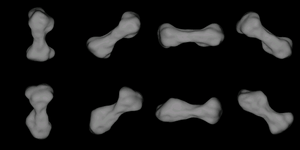216 Kleopatra facts for kids
216 Kleopatra is a special asteroid found in the main asteroid belt. This belt is a busy area between the planets Mars and Jupiter. An astronomer named Johann Palisa discovered Kleopatra on April 10, 1880, while he was in Pola (now called Pula). It was named after Cleopatra, the famous Queen of Egypt.
| Discovery | |
|---|---|
| Discovered by | Johann Palisa |
| Discovery date | April 10, 1880 |
| Designations | |
| A905 OA, A910 RA | |
| Main belt | |
| Orbital characteristics | |
| Epoch 30 January, 2005 (JD 2453400.5) | |
| Aphelion | 523.049 Gm (3.496 AU) |
| Perihelion | 312.544 Gm (2.089 AU) |
| 417.796 Gm (2.793 AU) | |
| Eccentricity | 0.252 |
| 1704.704 d (4.67 a) | |
|
Average orbital speed
|
17.82 km/s |
| 55.259° | |
| Inclination | 13.136° |
| 215.672° | |
| 179.099° | |
| Physical characteristics | |
| Dimensions | 217 × 94 × 81 km |
| Mass | unknown |
|
Mean density
|
3.5+ |
| 5.385 h | |
| Albedo | 0.116 |
| Temperature | unknown |
|
Spectral type
|
M |
| 7.3 | |
Contents
Kleopatra's Unique Shape
Kleopatra is a very unusual space rock because of its strange shape. It looks like a dog bone or a dumbbell! Scientists first saw its odd shape using special telescopes with "adaptive optics." This technology helps telescopes see more clearly through Earth's atmosphere.
How Scientists Saw Its Shape
Later, a team of astronomers used the giant Arecibo radio telescope in Puerto Rico. They sent radio signals towards Kleopatra. Then, they listened for the echoes that bounced back. By studying these echoes, they created a detailed computer model. This model confirmed that Kleopatra really does have a dog-bone shape.
What Made It So Odd?
One popular idea is that Kleopatra is a "contact binary." This means it's actually two asteroids that gently bumped into each other. Instead of breaking apart, they stuck together. Imagine two play-doh balls that you push together lightly. That's a bit like what scientists think happened to Kleopatra.
Size and What It's Made Of
Kleopatra is a pretty big asteroid. It measures about 217 kilometers long, 94 kilometers wide, and 81 kilometers thick. Scientists believe it's mostly made of metal. However, it might not be a solid chunk of metal. It could be more like a loose pile of metallic rubble that's held together. This idea comes from how much radar light it reflects.
- The Asteroid Orbital Elements Database
Images for kids
See also
 In Spanish: (216) Kleopatra para niños
In Spanish: (216) Kleopatra para niños




